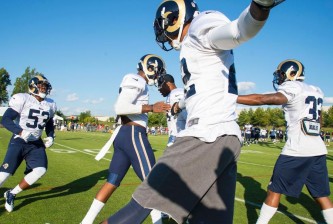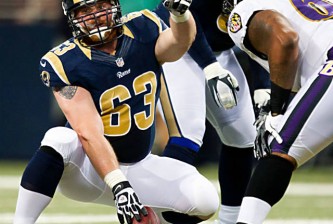
If 2011 was his job interview, Billy Devaney is in big trouble.
For most of his tenure in St Louis, the most maddening part of watching Rams GM Billy Devaney go about his business was his patience. As we sat in our virtual war rooms and howled for Devaney to sign this player or that, he stayed silent and waited. His renovation of the Rams roster was slow, methodical, and for the most part, effective.
From 2009-2010, Devaney and Spagnuolo identified dead wood and cut it loose, and replaced it with young players who were ready to buy in to what Spagnuolo and Steven Jackson were selling. Most of that youth came from their own draft board, with some players like Craig Dahl and Na’il Diggs coming from known systems.
The free agent solution was kept in a glass box behind Devaney’s desk, like a fire axe or a display pistol. It was used rarely, and only for a specific purpose when all else failed. (I’m not counting undrafted free agents here, an arena where Devaney has done well.)
2009 New Free Agent Starters: FB Mike Karney, TE Bily Bajema, C Jason Brown, DT Gary Gibson, LB Paris Lenon, S Craig Dahl, S James Butler
Brown was the only hotly contested free agent from this group, arguably the team’s most necessary signing and at the same time, perhaps its worst from this group. He was a legitimate Pro Bowl center in Baltimore, but the Rams quickly found that he couldn’t perform at the same level with lighter and less-disciplined guards on his flank.
The rest of these additions were added relatively late in free agency, bargain buys to fit specific needs. In 2010, Devaney took this smart-shopper mentality to an extreme.
2010 New Free Agent Starters: DT Fred Robbins, LB Na’il Diggs
The Rams were starting a host of other new faces as well, including WRs Mark Clayton, Laurent Robinson and Brandon Gibson, who were acquired by low-risk trades over the past year. But when it came to going shopping on the open market, Devaney kept his focus narrow and his purse closed.
His approach was frustrating to watch, but the results were fantastic. The Rams improved from 1-15 to 7-9, and none of us could argue that indeed a plan was in place, and was taking shape before our eyes. 10 of 14 regulars on offense and 8 of 11 on defense were either acquired in the draft, or with draft picks as collateral. And our special teams units and bench were loaded with players that were pushing for starting time.
But shortly afterwards, Bily Devaney and the Rams lost their way. This is how it happened.
The Rams became a victim of their success, and of the avarice of the NFL’s owners and players. Offensive coordinator Pat Shurmur was unexpectedly hired away, and with him went a man who bought into the cautious and patient approach. The man who replaced him, Josh McDaniels, was going to bring a different kind of energy, a brash expectation of change. We all wondered how this would work, but salivated at the prospect of building a set of explosive weaponry on top of the Rams’ carefully built foundation.
Then the Lockout interrupted business, and gave Devaney, Spagnuolo and McDaniels months of time to do little more than watch tape, deconstructing everything that they might improve on, and laying plans for a blitzkrieg of change when the league opened its doors again.
That day came on July 25, 2011. And simply put, the Rams went nuts. They signed Quintin Mikell and Harvey Dahl to top-dollar contracts within the first three days of free agency. And they kept on adding. Cadillac Williams, Jerious Norwood, Zac Diles, Stephen Spach, Al Harris, Justin Bannan, Dan Muir, Mike Sims-Walker and the much-maligned Ben Leber.
Twelve veteran players added in less than ten days to a chemistry experiment boiling over in Rams Park. Young players were pushed aside or cast off. And Spagnuolo took an unusually passive approach to his practices, with half of the team now under McDaniels’ control. Eleven on elevens became hard-hitting competitions between two groups of players working under two different mandates.
And when the roster cuts came, draftees were sent packing, and with them went a set of players who had bought in to Spagnuolo’s vision.
2011 New Free Agent Starters (Week 1): S Quintin Mikell, RG Harvey Dahl, RB Cadillac Williams, RB Jerious Norwood, CB Al Harris, DT Justin Bannan, LB Ben Leber, WR Mike Sims-Walker.
Even after the cutdown to 53, Devaney kept sticking to a “more has got to be better” philosophy, re-signing Mark Clayton and adding Brandon Lloyd to an already overstuffed receiver corps, and constantly working the phones to find injury fill-ins for his offensive line and secondary.
It was thrilling, but also confusing. Rather than take a silver bullet approach to free agency, Devaney and company brought a gatling gun and was firing away, spent shells scattering across the floor. This for a team who had seemingly already completed the tough part of the rebuilding process, who had already changed the culture of a losing team into one that had learned how to compete and win.
That culture is still evident now, but only on defense, as Spagnuolo has started to reject mercenaries like Leber who failed to buy in, and turned his trust back to his guys. The offense remains a dischordant mess without shape or reason.
Even though some of these signings have worked out — Dahl is approximately a billion times better at guard than Adam Goldberg was — Devaney’s approach didn’t. At a high level, the Rams fell into a class of teams, like the Eagles, Redskins and Dolphins, who went nutty in free agency and lost. Meanwhile teams like the 49ers who stayed patient, teams who waited in free agency before striking, have shot ahead of the pack.
Patience used to be Devaney’s M.O, a symbol of his plan. Now, even if he survives the purge that is certainly coming to this team after this disaster of a season, we honestly don’t know what the plan is, or whether to trust him with it.






















